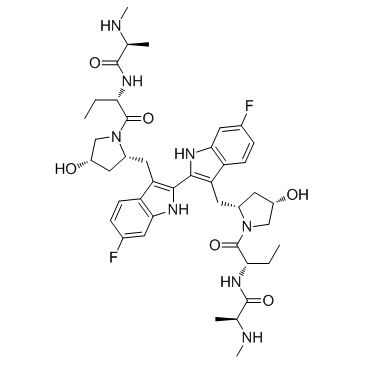Birinapant
Modify Date: 2025-08-21 16:40:54

Birinapant structure
|
Common Name | Birinapant | ||
|---|---|---|---|---|
| CAS Number | 1260251-31-7 | Molecular Weight | 806.94 | |
| Density | 1.3±0.1 g/cm3 | Boiling Point | 1090.5±65.0 °C at 760 mmHg | |
| Molecular Formula | C42H56F2N8O6 | Melting Point | N/A | |
| MSDS | N/A | Flash Point | 613.3±34.3 °C | |
Use of BirinapantBirinapant, a bivalent Smac mimetic, is a potent antagonist for XIAP and cIAP1 with Kds of 45 nM and less than 1 nM, respectively. |
| Name | (2S)-N-[(2S)-1-[(2R,4S)-2-[[6-fluoro-2-[6-fluoro-3-[[(2R,4S)-4-hydroxy-1-[(2S)-2-[[(2S)-2-(methylamino)propanoyl]amino]butanoyl]pyrrolidin-2-yl]methyl]-1H-indol-2-yl]-1H-indol-3-yl]methyl]-4-hydroxypyrrolidin-1-yl]-1-oxobutan-2-yl]-2-(methylamino)propanam |
|---|---|
| Synonym | More Synonyms |
| Description | Birinapant, a bivalent Smac mimetic, is a potent antagonist for XIAP and cIAP1 with Kds of 45 nM and less than 1 nM, respectively. |
|---|---|
| Related Catalog | |
| Target |
Kd: 45 nM (XIAP), <1 nM (cIAP1) |
| In Vitro | Birinapant causes significant degradation of cIAP1 and 2. Birinapant + TRAIL-treated cells show increased levels of active caspase-8 and caspase-3, as well as PARP cleavage, over single agents within 4 h of treatment, indicative of apoptosis-mediated cell death. Birinapan significantly decreases the viability of SUM190 cells in a dose-dependent manner. Birinapant treatment in the XIAP knockdown cell line (SUM190 shXIAP) causes an overall reduction in viability at lower doses (30-300 nM)[1]. Birinapant causes apoptosis in the sensitive cells. Birinapant in conbination with TNF-α, causes PARP cleavage in 451Lu and WM1366 cell lines[2]. Birinapant induces time-course of caspase-3 activation in HCT116 human colon carcinoma and MDA-MB-231 human breast adenocarcinoma cells[3]. |
| In Vivo | Birinapant can inhibit tumor growth in melanoma xenotransplantation models. Staining for activated caspase-3 in biopsies of the same tumors show a modest increase in apoptotic cells in the birinapant treated animals[2]. Birinapant (15 mg/kg, i.p.) induces apoptosis in HCT116 tumor-bearing mouse[3]. |
| Cell Assay | Trypan blue exclusion assay is performed as described. Cells are seeded in 6 well plates at 7.5×104 (SUM149) or 1.5×105 (SUM190) cells per well and allowed to adhere overnight. Cells are treated with TRAIL (0-100 ng/mL), Birinapant (0-10,000 nM), GT13402 (0-10,000 nM), TNF-α (50 ng/mL), TNF-α neutralizing antibody (10 μg/mL), pan-caspase inhibitor Q-VD-OPh (20 μM), or a combination as indicated. All treatments are applied for 24 h, and then the cells are trypsinized and resuspended in PBS. Next, 10 μL of cell suspension is added to 10 μL 0.4 % trypan blue, and 10 μL of the mixture is loaded onto a hemocytometer; cells are counted, and live and dead cell numbers are recorded. |
| Animal Admin | Ten animals each are inoculated s.c. with 1×106 451Lu or 1205Lu human melanoma cells in a suspension of matrigel/complete media at a ratio of 1:1. After formation of palpable tumors, mice from both tumor models are randomized into two groups. Both groups are treated intraperitoneal three times/week with either vehicle control or birinapant 30 mg/kg for 21 days. Birinapant is dissolved in 12.5% Captisol in distilled water. Tumor size is assessed twice weekly by caliper measurement. Subsequently, satellite groups of ten and fifteen mice are inoculated in the same fashion with 451Lu and 1205Lu tumor cells respectively. After tumors have reached a mean volume of 200 mm3 animals are dosed with either birinapant or vehicle control as described above. After 48 hours and two doses, animals are sacrificed and tumors are harvested at four time points after the last treatment. Tumor samples are snap frozen in liquid nitrogen for subsequent protein analysis and preserved as FFPE blocks for immune-histochemistry. |
| References |
| Density | 1.3±0.1 g/cm3 |
|---|---|
| Boiling Point | 1090.5±65.0 °C at 760 mmHg |
| Molecular Formula | C42H56F2N8O6 |
| Molecular Weight | 806.94 |
| Flash Point | 613.3±34.3 °C |
| PSA | 174.10000 |
| LogP | 2.98 |
| Vapour Pressure | 0.0±0.3 mmHg at 25°C |
| Index of Refraction | 1.628 |
| InChIKey | PKWRMUKBEYJEIX-DXXQBUJASA-N |
| SMILES | CCC(NC(=O)C(C)NC)C(=O)N1CC(O)CC1Cc1c(-c2[nH]c3cc(F)ccc3c2CC2CC(O)CN2C(=O)C(CC)NC(=O)C(C)NC)[nH]c2cc(F)ccc12 |
| Hazard Codes | Xi |
|---|---|
| HS Code | 29339900 |
| Precursor 1 | |
|---|---|
| DownStream 0 | |
| Birinapant [USAN] |
| TL32711 |
| (2S,2'S)-N,N'-[(6,6'-Difluoro-1H,1'H-2,2'-biindole-3,3'-diyl)bis{methylene[(2R,4S)-4-hydroxy-2,1-pyrrolidinediyl][(2S)-1-oxo-1,2-butanediyl]}]bis[2-(methylamino)propanamide] |
| (2S,2'S)-N,N'-[(6,6'-difluoro-1H,1'H-2,2'-biindolyl-3,3'-diyl)bis{methylene[(2R,4S)-4- hydroxypyrrolidine-2,1-diyl][(1S)-1-ethyl-2-oxoethylene]}]bis[2- (methylamino)propanamide] |
| Propanamide, N,N'-[(6,6'-difluoro[2,2'-bi-1H-indole]-3,3'-diyl)bis[methylene[(2R,4S)-4-hydroxy-2,1-pyrrolidinediyl][(1S)-1-ethyl-2-oxo-2,1-ethanediyl]]]bis[2-(methylamino)-, (2S,2'S)- |
| Birinapant (USAN/INN) |
| Propanamide, N,N'-[(6,6'-difluoro[2,2'-bi-1H-indole]-3,3'-diyl)bis[methylene[(2R,4S)-4- hydroxy-2,1-pyrrolidinediyl][(1S)-1-ethyl-2-oxo-2,1-ethanediyl]]]bis[2-(methylamino)-, (2S,2'S)- |
| T56 BMJ HF C1- BT5NTJ AVY2&MVY1&M1 DQ& C- CT56 BMJ HF D1- BT5NTJ AVY2&MVY1&M1 DQ &&Stereoisomer |
| Birinapant |
| N-{(1S)-[(2R)-(6,6'-difluoro-3'-{(4S)-hydroxy-1-[(2S)-[(2S)-methylaminopropionylamino]butyryl]pyrrolidin-(2R)-2-ylmethyl}-1H,1 'H-[2,2']biindolyl-3-ylmethyl)-(4S)-hydroxypyrrolidine-1-carbonyl]propyl}-(2S)-methylaminopropionamide |
![acetic acid 5-[3'-(4-acetoxypyrrolidin-2-ylmethyl)-6,6’-difluoro-1H,1'H-[2,2']biindolyl-3-ylmethyl]pyrrolidin-3-yl ester Structure](https://image.chemsrc.com/caspic/117/1260251-26-0.png) CAS#:1260251-26-0
CAS#:1260251-26-0